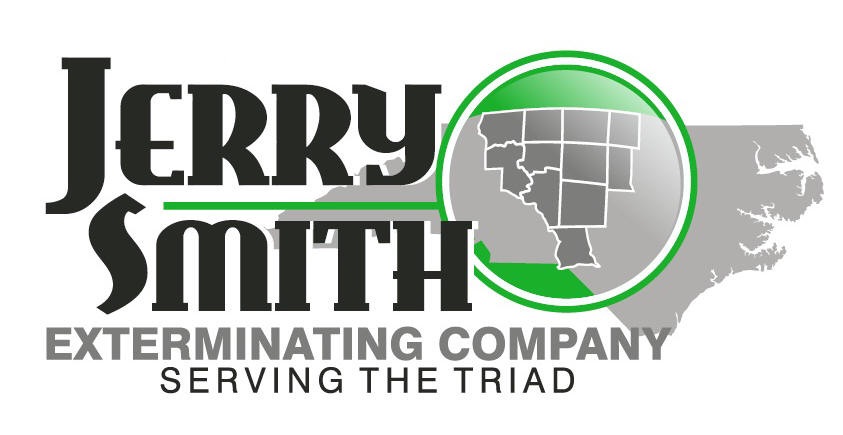Termites
are the major wood-destroying structural pests
in the southern United States. According to some
estimates, over $2 billion are spent annually in
the U.S. controlling or preventing termite
infestations. In North Carolina, our main
problem is with
subterranean termites,
i.e., termites that normally live below ground
and may move up into a structure where they
cause damage.
 Termites
are "social insects", i.e., they live in a nest
or colony which is typically found underground,
often near a tree, stump, wood pile or other
source of 'food'. Each colony contains a king
and queen who are brown in color. The queen is
able to lay thousands of eggs each year. There
are also soldier termites which have large heads
equipped with large mandibles ("jaws"). The
soldiers protect the colony from invaders (such
as ants). The majority of the colony consists of
thousands of whitish workers who have various
jobs within the colony. Some workers take care
of the queen and the newly hatching immatures
(sometimes called "larvae"). Other workers
forage (search) for food. The foraging workers
are the ones that we find infesting wood. As the
colony grows, the workers expand the nest and
their feeding area. A mature colony will contain
200,000 to 2,000,000 workers, although many
colonies contain as few as 50,000-60,000.
Studies have also shown that termites from a
single colony may forage across an area of
one-third acre and travel over 200 feet from
their nest. One acre of land may support several
termite colonies (although this doesn't mean
that all of them are invading your home!). A
large termite colony does not usually occupy a
single underground nest. As the foraging area
expands the colony actually splits to form
several smaller "nesting sites".
Termites
are "social insects", i.e., they live in a nest
or colony which is typically found underground,
often near a tree, stump, wood pile or other
source of 'food'. Each colony contains a king
and queen who are brown in color. The queen is
able to lay thousands of eggs each year. There
are also soldier termites which have large heads
equipped with large mandibles ("jaws"). The
soldiers protect the colony from invaders (such
as ants). The majority of the colony consists of
thousands of whitish workers who have various
jobs within the colony. Some workers take care
of the queen and the newly hatching immatures
(sometimes called "larvae"). Other workers
forage (search) for food. The foraging workers
are the ones that we find infesting wood. As the
colony grows, the workers expand the nest and
their feeding area. A mature colony will contain
200,000 to 2,000,000 workers, although many
colonies contain as few as 50,000-60,000.
Studies have also shown that termites from a
single colony may forage across an area of
one-third acre and travel over 200 feet from
their nest. One acre of land may support several
termite colonies (although this doesn't mean
that all of them are invading your home!). A
large termite colony does not usually occupy a
single underground nest. As the foraging area
expands the colony actually splits to form
several smaller "nesting sites".
SIGNS OF TERMITE ACTIVITY
[
TOP
]
Without a periodic inspection of your home,
termite activity can remain undetected for
years. Some signs of their activity show up
unexpectedly, while others are discovered by
accident or during renovations. Here are some
key signs of a termite infestation:
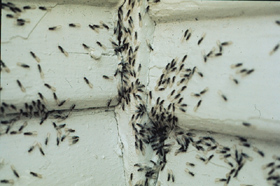 Swarming
-
Swarming
-
A termite colony matures in
3-5 years and begins to produce swarmers (winged
adults). In North Carolina, we have at least
three species of termites that begin swarming in
late winter and continue into September or
October. Swarming usually occurs during the day,
particularly on warm days following rain.
Swarmers found outdoors near tree stumps,
landscape timbers, etc., are
not an indication that
your house is infested, but they serve as a
reminder that termites live around us. When
swarming occurs indoors, it usually means that
you have an infestation somewhere within your
house. Several species of ants also swarm at the
same times of the year as termites. Winged
termites and ants look somewhat similar, but you
can tell them apart by certain features. If
you're not sure whether you have termites or
ants, contact us for identification.
Mud tubes
[
TOP ]
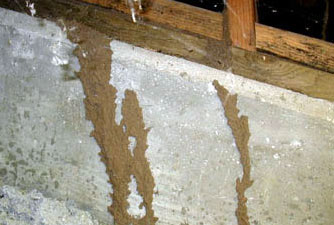 Unlike
ants, termites do not roam around out in the
open. They will either tunnel through wood (or
other material) or else travel inside
pencil-size (or larger) mud tubes that they
build from soil, wood particles and other
materials. You will find these tubes on
foundation walls, floor joists or other parts of
the house. Tubes may also hang from the floor
system or may be found protruding from cracks
between boards and beams and even through holes
termites have chewed through sheet rock on walls
and ceilings. Break open the tubes to see if
termites are still active. An empty tube doesn't
necessarily mean that termites are gone; they
may have simply abandoned this particular
tunnel. Termites often rebuild damaged tubes,
which is another indication of current activity.
'Old' tubes are dry and crumble easily, leaving
behind "etching" on the surface that may be
visible for years (an indication that a house
had termite activity at some time). Without
knowing the inspection history of the house, it
is impossible to tell or guess at the age of
tunnels or etching.
Unlike
ants, termites do not roam around out in the
open. They will either tunnel through wood (or
other material) or else travel inside
pencil-size (or larger) mud tubes that they
build from soil, wood particles and other
materials. You will find these tubes on
foundation walls, floor joists or other parts of
the house. Tubes may also hang from the floor
system or may be found protruding from cracks
between boards and beams and even through holes
termites have chewed through sheet rock on walls
and ceilings. Break open the tubes to see if
termites are still active. An empty tube doesn't
necessarily mean that termites are gone; they
may have simply abandoned this particular
tunnel. Termites often rebuild damaged tubes,
which is another indication of current activity.
'Old' tubes are dry and crumble easily, leaving
behind "etching" on the surface that may be
visible for years (an indication that a house
had termite activity at some time). Without
knowing the inspection history of the house, it
is impossible to tell or guess at the age of
tunnels or etching.
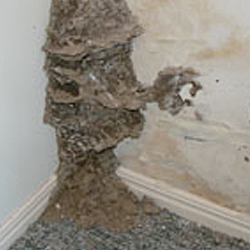 Tubes
that are found on ceilings or on the second
floor of buildings may indicate that you have a
"secondary" or aboveground ("aerial")
infestation, i.e., the termite colony actually
lives in the building and the termites are
traveling up from the soil. Mud tubes built by
an aboveground colony usually contain materials
other than soil, e.g., wood and sheet rock or
whatever the termites are feeding on. Secondary
infestations occur when there is a serious
moisture problem or leak somewhere within the
structure. In such situations, a thorough
inspection may require removal of siding or
interior wallboards, etc. More importantly for
you, secondary infestations cannot be controlled
with the usual soil treatments alone. Finding
and correcting the moisture problem is the first
step to eliminating the termites.
Tubes
that are found on ceilings or on the second
floor of buildings may indicate that you have a
"secondary" or aboveground ("aerial")
infestation, i.e., the termite colony actually
lives in the building and the termites are
traveling up from the soil. Mud tubes built by
an aboveground colony usually contain materials
other than soil, e.g., wood and sheet rock or
whatever the termites are feeding on. Secondary
infestations occur when there is a serious
moisture problem or leak somewhere within the
structure. In such situations, a thorough
inspection may require removal of siding or
interior wallboards, etc. More importantly for
you, secondary infestations cannot be controlled
with the usual soil treatments alone. Finding
and correcting the moisture problem is the first
step to eliminating the termites.
Termite
Damage
[
TOP
]
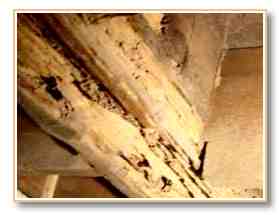 We
tend to think of termites as feeding/injuring
wood only. Termites actually feed on almost
anything that contains cellulose, the main
component of wood, including wood paneling,
paper products, cardboard boxes, art canvases,
the paper covering of sheet rock, carpeting,
etc. While foraging and feeding, they may tunnel
through non-cellulosic materials, such as
plastic and foamboard. According to some
research, a colony containing 60,000 workers
could consume the equivalent of one foot of a 2"
x 4" piece of lumber in slightly over 5 months.
In reality, the amount of damage that termites
cause depends on many factors. In areas with
cold winter temperatures, termite activity (and
feeding) often declines, but does not
necessarily stop. If the termites are
well-protected from colder temperatures (e.g.,
underneath a slab), then activity may continue
year-round. From a practical perspective,
serious termite damage usually takes about 3-8
years.
We
tend to think of termites as feeding/injuring
wood only. Termites actually feed on almost
anything that contains cellulose, the main
component of wood, including wood paneling,
paper products, cardboard boxes, art canvases,
the paper covering of sheet rock, carpeting,
etc. While foraging and feeding, they may tunnel
through non-cellulosic materials, such as
plastic and foamboard. According to some
research, a colony containing 60,000 workers
could consume the equivalent of one foot of a 2"
x 4" piece of lumber in slightly over 5 months.
In reality, the amount of damage that termites
cause depends on many factors. In areas with
cold winter temperatures, termite activity (and
feeding) often declines, but does not
necessarily stop. If the termites are
well-protected from colder temperatures (e.g.,
underneath a slab), then activity may continue
year-round. From a practical perspective,
serious termite damage usually takes about 3-8
years.
Look for these signs of
termite feeding:
-
Wood that sounds "hollow" when it is tapped
with the handle of a screwdriver.
-
Soft wood that is easily probed with a knife
or screwdriver.
- A
thin gritty gray-brown film on the surface
of damaged material.
There is no accurate method for determining the
age of recently discovered damage. You need some
reference point, i.e., some point in time when
it was known that there was no damage to this
particular wood. This is one reason why annual
inspections (and keeping your records of these
inspections) are invaluable.
NOTE:
These inspections are not a guarantee that you
do not have termites or damage in
visually-inaccessible areas, such as inside
walls. However, the inspections can reveal
conditions that might suggest that damage does
exist and further investigation is needed
